2019 Building America Report Menu
Our Company
Union Pacific Railroad Company is the principal operating company of Union Pacific Corporation (NYSE: UNP). We are one of America's most recognized companies, with a heritage of building the country and a vision to keep doing so.
Our rail network connects 23 states in the western two-thirds of the country, providing a critical link in the global supply chain. Over the last 10 years, from 2010 to 2019, Union Pacific invested $34.5 billion in our network and operations, supporting America's transportation infrastructure and enabling economic growth.
- Fast Facts
- Corporate Strategy
- Unified Plan 2020
- Financial Performance
- Risk Oversight Approach
- Board of Directors
- Environmental, Social and Governance (ESG) Approach
- Material Issues
- Sustainable Development Goals
- Key Performance Indicators
- Stakeholder Engagement
- Key Awards and Recognition
- The Great Race: 150th Anniversary Celebration
- What's Ahead
Brakeman Bobby Woods uses a remote control to move locomotives in Union Pacific's Long Beach, California, yard.
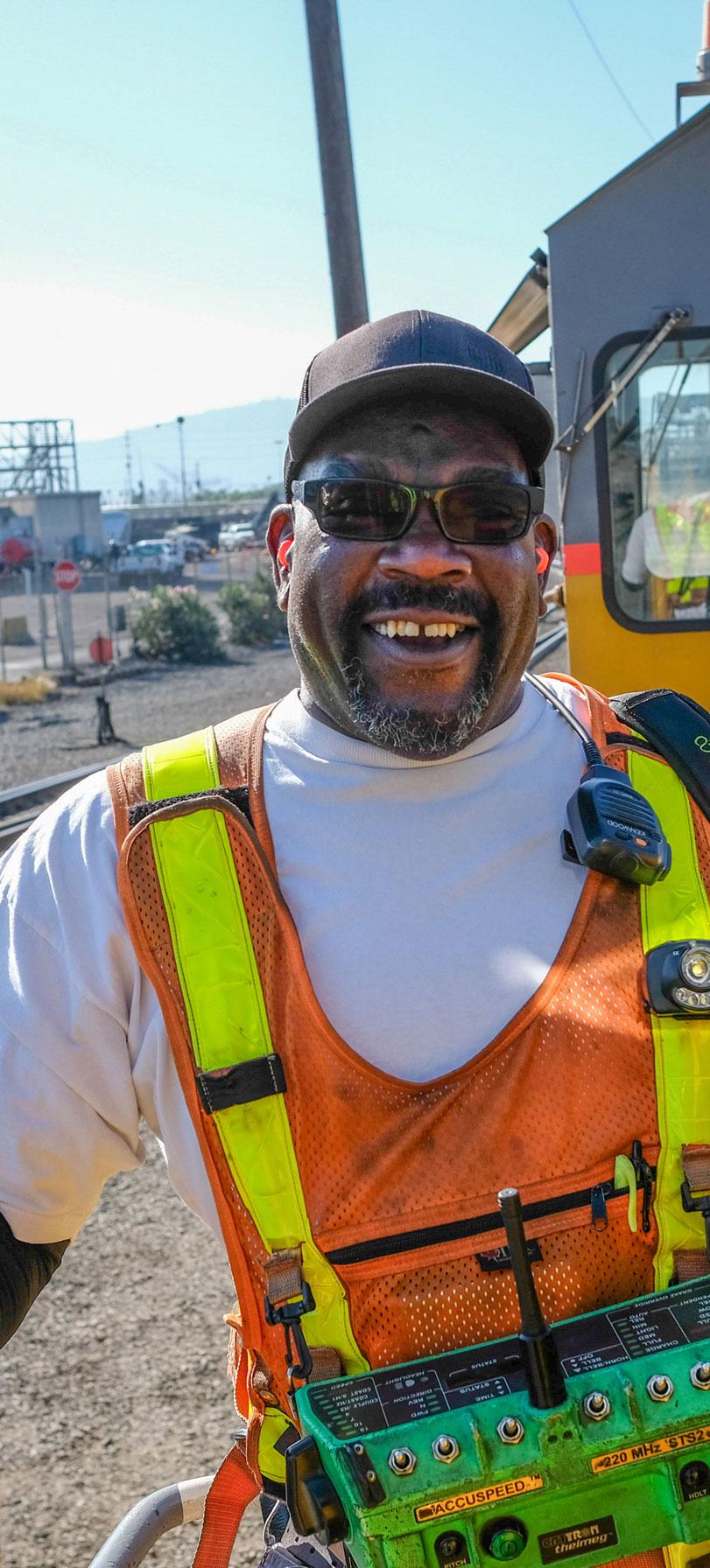
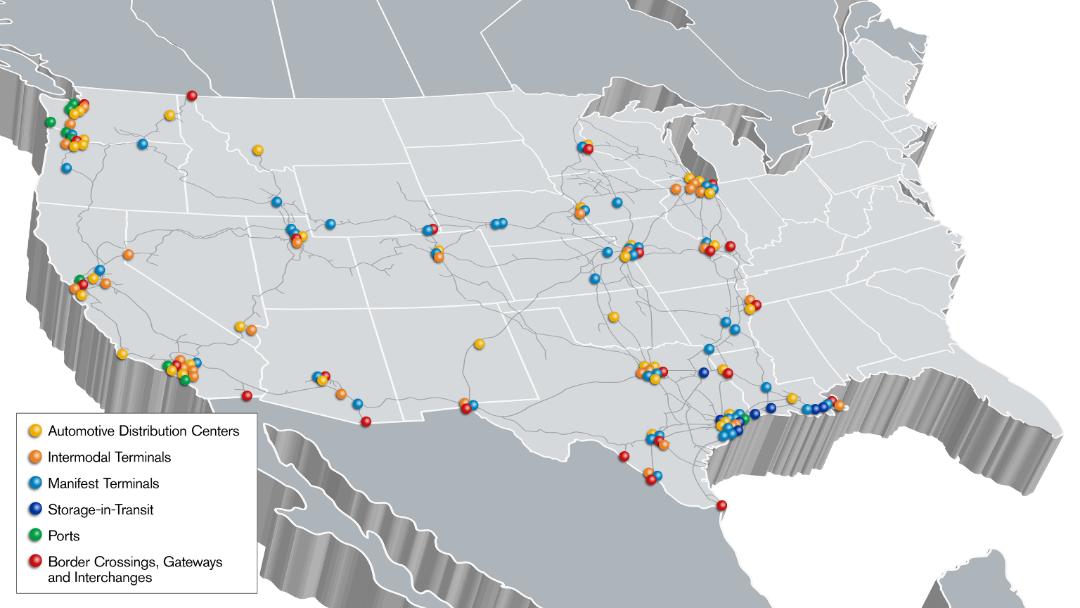
Vision
We Build America for all generations by connecting our nation's businesses and communities to each other and the world.
Purpose
The people of Union Pacific deliver North America's safest, most reliable and most efficient supply chain solutions.
Values
Passion for Performance
Passion, determination and expertise drive our safety, customer experience and financial results.
High Ethical Standards
Our reputation will always be a source of pride for our employees and a bond with our customers, shareholders and communities.
Work as a Team
We work together, embrace diversity and create opportunity for all. We promote an inclusive environment where people from varied backgrounds can be their best, reflect the communities where we live and work, and deliver a competitive advantage
Fast Facts
32,340
Route Miles in 23 States
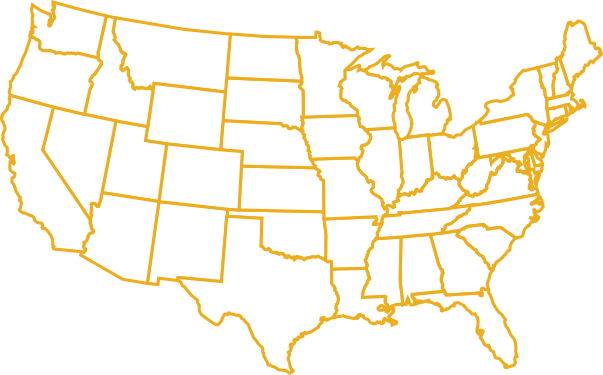
7
Border
Crossings

8.3
Million
Annual Carloads

7,700 Locomotives

57,000 Rail Cars

37,500 Employees

30,000
Railroad
Crossings

18,000 Bridges
Corporate Strategy
Union Pacific's goal is clear: Be the best freight railroad in North America. This means we're the safest, the most reliable and the most efficient.
The "how" also is evident. Operational excellence and an engaged workforce with deep market knowledge and strong customer relationships will result in best-in-class safety, customer experience and shareholder returns.
We revised our strategy in 2018 and focused on its rollout and implementation in 2019. The six value tracks used in our previous strategy live on in our strategy wheel, providing employees a clearer picture of the railroad's strategic intent. The following individual strategic elements work together to turn the wheel, driving Union Pacific forward:
- Safest and Most Reliable Freight Rail Products and Services. Everything we do must be done safely, or we don't do it – that's our promise to each other. We also must be reliable so customers trust we'll deliver on our promises. Unified Plan 2020, our operating plan, accomplishes this by creating an achievable transportation plan customers can count on.
- Highly Efficient Operations . Driving down cost and removing waste helps us be more competitive, enabling us to enter new markets. The faster we turn our assets – whether it's a locomotive or a freight car – the bigger the return on our investment
- Industry-Leading Customer Experience. Continuously improving the customer journey provides higher levels of service and better transparency into customers' transportation supply chains, helping them win in their markets.
- Secure Appropriate Business. Selling products that fit our business model versus developing boutique services builds a consistent, balanced network. We will continue finding solutions that customers value, but those services also must optimize our network.
- Best-in-Industry Cash Returns. Each employee plays a role, from getting price on a contract to finding efficiencies in everyday work. This gives shareholders confidence in our ability to create financial returns, allowing us to invest in and grow our business.
- Optimal Investment. Every dollar spent must drive safe, reliable and efficient results. We invest in areas customers are willing to pay for, whether it's improving car cycle time, updating track infrastructure on vital corridors or developing digital tools that help them plan their business.
- Proud and Engaged Workforce. The wheel turns when our employees work toward the same goals. It takes the best employees in the industry to become the best freight railroad in North America – we have that, and there is nothing stopping us from achieving our vision.
As we transform our railroad into the safest, most reliable and most efficient in North America, our values will continue guiding us: Our passion for performance will help us win; our high ethical standards will ensure we don't win at the expense of any one stakeholder; and our teamwork will make sure we win together.
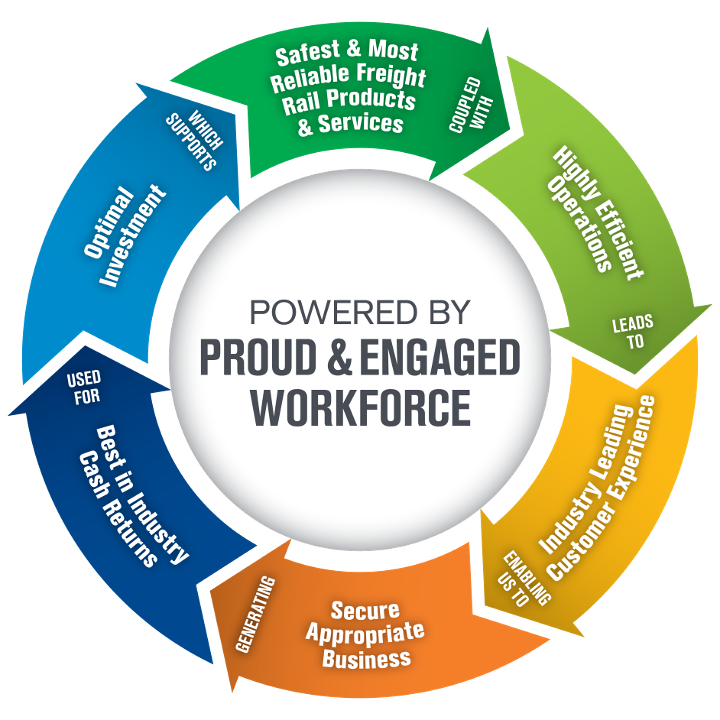
Unified Plan 2020
Union Pacific faced several headwinds in 2019, including international trade uncertainty and a 6% decline in carloadings from 2018. Despite that, we transformed our transportation plan and service product in a way that only happens once in a generation. Unified Plan 2020 is working, and it's putting us in charge of our future. The plan implements Precision Scheduled Railroading (PSR) principles and is an important part of our objective to operate a safe, reliable and efficient railroad.
While PSR has been implemented at other North American railroads, we took a clean-sheet approach to develop our plan. We incorporated the experience and expertise of employees closest to the work, including those in the field. Unified Plan 2020 encompasses the following principles:
- Shifting the focus of operations from moving trains to moving cars.
- Minimizing car dwell, car classification events and locomotive power requirements.
- Utilizing general-purpose trains by blending existing train services.
- Balancing train movements to improve the utilization of crews and rail assets.
Our goal is to move cars faster and reduce the number of times each is touched. The end result is we're delivering a better customer experience. First Mile, Last Mile, which measures if we delivered and picked up cars to and from customer facilities as scheduled, is up 6 points to 91% from 2018. We're driving down Freight Car Dwell to record levels, shaving off approximately 5 hours. Customers' cars are moving 12 miles-per-day faster, meaning fewer cars are needed to move the same volume, and product is getting to market quicker and more reliably.
Increasing train size remains one of our main areas of focus. By putting more products on fewer trains, we're being smart with how we use our locomotives, meaning we're using less fuel and reducing our overall greenhouse gas emissions. We've increased train length systemwide by 16%, more than 1,100 feet since the fourth quarter 2018.
The work our employees are doing as part of Unified Plan 2020 has been transformational and key to providing a safe, reliable and efficient service product to our customers. Their dedication to teamwork allows us to focus on high-value work and eliminate tasks that do not directly support Unified Plan 2020. We are pleased with the progress we made in 2019, and we expect to see continued improvement going forward.
What Does Unified Plan Mean To…
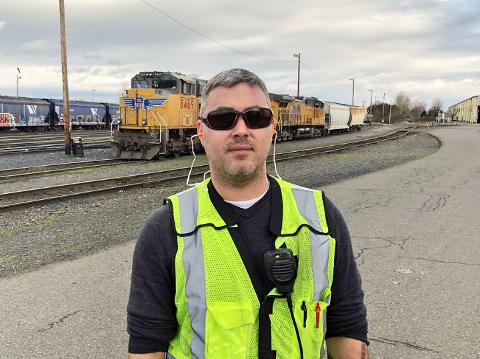
Train Crew
"Along with physically moving cars, I confirm they are on the right track and in the correct order on a mobile device. It takes time, but some rule changes make switching more efficient, and I'm proud of our team for working injury free."
Chris Brodigan, switchman, Portland, Oregon
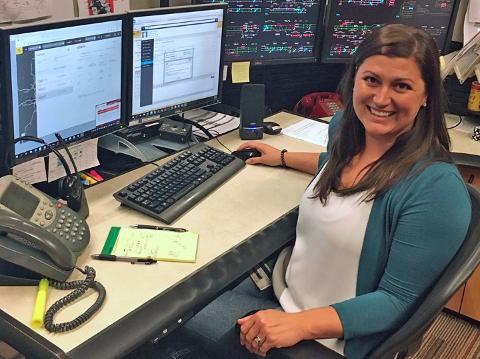
Train Dispatchers
"We have the same goal as our field counterparts: Find the quickest way to move the car and keep it moving along the right path to destination. Previously, we would've waited for the scheduled transportation plan to do a certain pickup or set-out. Now, when there's an opportunity to move a block of cars onto a train, a request is made to stop the train to pick up those cars. We've had to expand our skill sets, constantly think ahead and be proactive. It's building a stronger team."
Sarah Vogel, corridor manager, Harriman Dispatching Center, Omaha, Nebraska
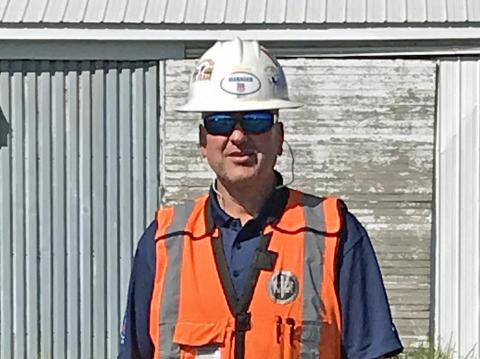
Engineering
"The focus on moving cars faster means we have shorter track curfews (the scheduled time when train traffic halts, allowing Maintenance of Way employees to safely work on the track). We're adjusting work schedules, collaborating with service units and being smart about time management. It takes a team effort – everyone helps each other to make the process as smooth as possible. The result is increased speed, but our biggest win is we're doing the work safely."
Jamie Becker, manager-Track Projects, Engineering, Columbus, Nebraska
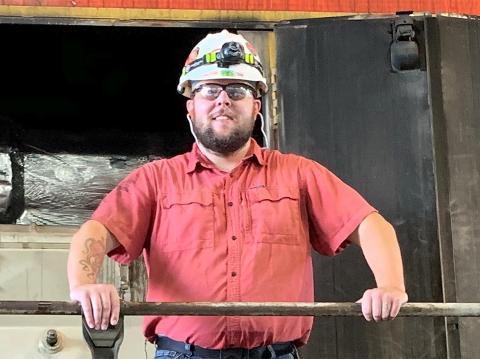
Mechanical
"It's all about people, parts and locomotives. If possible, we'll do [repair] tasks outside of the shop to free it up for the heavy work. This provides space and crews, making us quicker. It's a team effort – we're constantly communicating throughout the day."
Don Thomas Jr., senior manager – System Locomotive Facility, Livonia, Louisiana
Determining a Hump Yard's Role
Unified Plan 2020 gave Union Pacific a blank slate, an opportunity to forgo precedent and design a network focused on safety, service reliability and efficiency. At the new transportation plan's crux: sending cars deep into the network with the fewest possible touches.
"You should never touch a car more than you have to, from the customer releasing it to the car's final destination," said Jim Vena, chief operating officer. "When you remove touch points, you're faster, you're more efficient and you're more reliable."
This new philosophy, focusing on moving cars rather than trains, challenged the practice of routing manifest, or mixed commodity, traffic through hump yards.
Finding the Network's Best Fit
It's a common misconception that the first order of business for a Precision Scheduled Railroad is closing hump yards. The more accurate question should be: Does it make operational sense for the car to stop there?
Hump yards can serve an important purpose on Union Pacific's network. Yards sorting upward of 2,000 cars daily are most efficient using a hump. Inbound rail cars are pushed up a hill (hump), uncoupled and rolled downhill into the bowl's computer-controlled sorting tracks, consolidating into blocks of cars based on common destinations.
Originally built at natural traffic confluences, hump yards seem like logical pit stops. But each time a car touches a yard, it adds about 24 hours to its journey. The key to an efficient network is ensuring cars stop only when and where they need to. When a hump yard's inbound traffic is reduced, it becomes more cost-effective for the yard to flat switch. Flat switching accomplishes the same outcome, without maintaining and using an expensive hump process.
Converting a hump yard to flat switching doesn't physically remove the hump. Instead, inbound cars bypass the hump and are sorted by a switch crew on the yard's trim lead or the track used to move cars from the sorting tracks to the departure yard.
Before converting switching operations, Network Planning & Operations uses modeling software to simulate transportation plan changes. This helps the team understand potential impact to mileage, transit time and train starts; visualize how many additional cars will flow into a terminal; and see how long trains coming out of those terminals will be.
Streamlining the transportation plan enabled Union Pacific to convert hump yards in Pine Bluff, Arkansas; Hinkle, Oregon; and Proviso, Illinois, to flat switching. Pine Bluff in particular is reaping the benefits. Since converting in February, the terminal steadily improved its Freight Car Productivity by reducing freight car dwell 30% in July alone versus last year.
In addition to converting some hump yards to flat switching, we stopped humping cars in Fort Worth, Texas, and Kansas City, Kansas. In some cases, we're reducing switching at one yard and moving the work to a nearby facility.
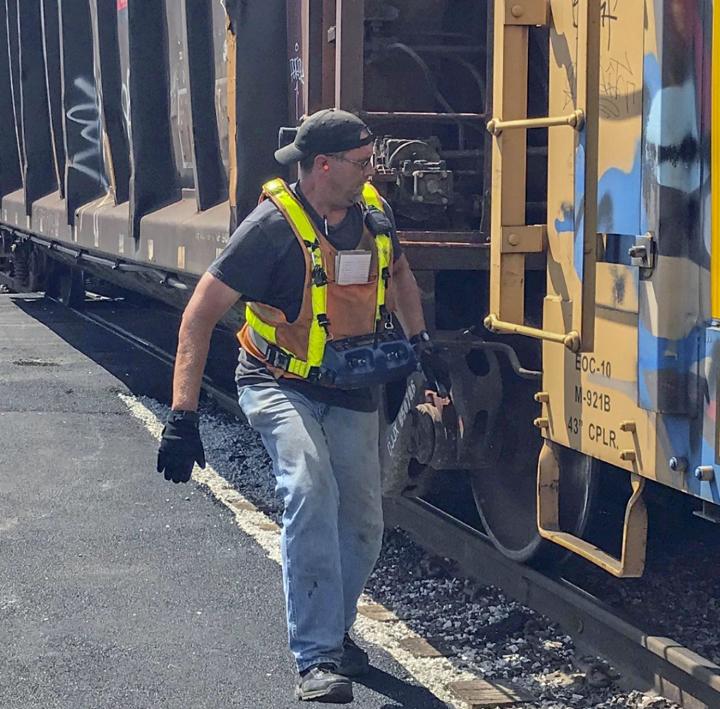
James Masek Jr. flat switches cars in Proviso's Yard 9 in Chicago, Illinois.
Financial Performance
Freight railroads are the backbone of the U.S. economy, supporting the livelihoods of employees in most sectors. In fact, one job in the rail sector supports eight others across the economy.1 Union Pacific’s diversified portfolio generates operating income and shareholder returns, further stimulating the economy.
For the full year, Union Pacific reported net income of $5.9 billion or $8.38 per diluted share, which represents a 1% decrease and a 6% increase, respectively, compared to 2018. Operating revenue totaled $21.7 billion compared to $22.8 billion in 2018, while operating income of $8.6 billion remained flat.
Freight revenue totaled $20.2 billion, a 5% decrease compared to 2018. The growth we experienced in industrial products was more than offset by fewer agriculture products, premium and energy shipments.
Given the challenging volume environment, we leveraged strong productivity to deliver solid financial results.
1 Source: American Association of Railroads
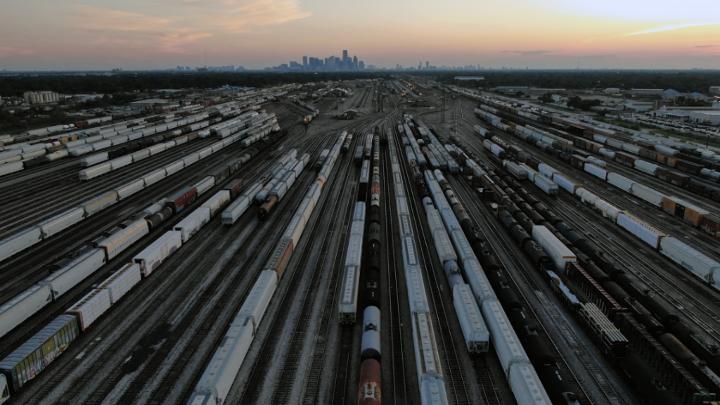
Englewood Yard in Houston, Texas, where trains await departure.
Risk Oversight Approach
We continuously monitor our dynamic risk management process to identify and address potential concerns, including those arising in the ever-changing economic, political and legal environments in which Union Pacific operates.
Management identifies and prioritizes enterprise risks and regularly presents them to our board of directors for review and consideration. Our chief compliance officer reports to the board on risk mitigation strategies, supported by senior executives responsible for implementing risk mitigation. We also report risk factors in our Annual Report Form 10-K .
The board’s Audit Committee oversees internal audits of the company’s enterprise risks. Internal auditors present their findings on mitigating controls and processes to the committee, which, in turn, reports to the board.
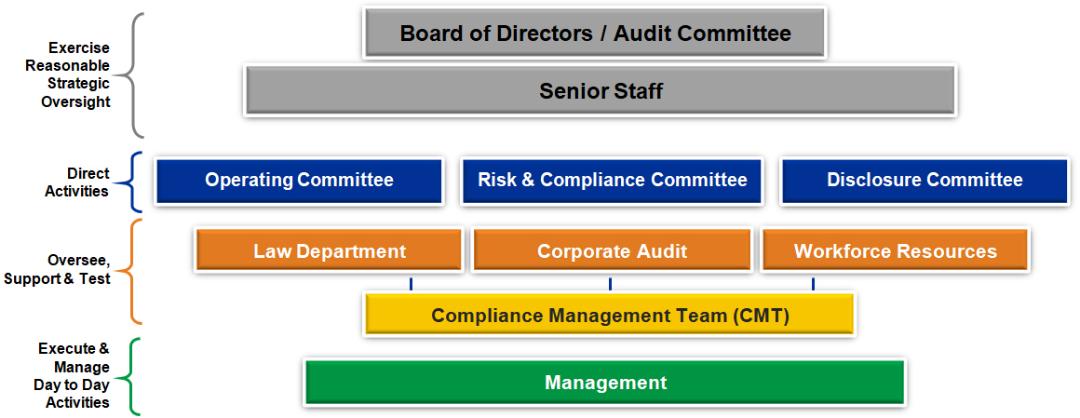
Board of Directors
Union Pacific works on behalf of our shareholders, employees, customers and communities to be among the best-governed companies in America. Our efforts begin with our board of directors, which is comprised of a majority of independent directors, including no more than two management directors at any given time. At year-end, our board consisted of 11 independent and one management director. Our board has four standing committees: the Audit Committee, Finance Committee, Compensation and Benefits Committee, and Corporate Governance and Nominating Committee. Each is comprised entirely of independent directors and operates under a written charter adopted by the board.
We expect directors to attend all regularly scheduled meetings, as well as their committee meetings and the annual board of directors meeting in May. In 2019, the board met six times. None of the directors attended fewer than 75% of the aggregate number of board meetings and the committees on which he or she served.
Board Membership Criteria
The Corporate Governance and Nominating Committee is responsible for developing and periodically reviewing the appropriate skills and characteristics required of our board members. The committee develops and recommends membership criteria to the board, including factors such as business and management experience; familiarity with the business; Union Pacific customers and suppliers; diverse talents; backgrounds and perspectives; as well as relevant regulatory and stock exchange membership requirements.
Evaluation Of Board And Committee Performance
The Board and its Committees conduct self-evaluations annually to assess their performance. The evaluation process includes a self-assessment that invites comments on all aspects of the Board and each Committee’s process. These evaluations serve as the basis for a discussion of Board and Committee performance as well as recommended improvements.
Our Directors
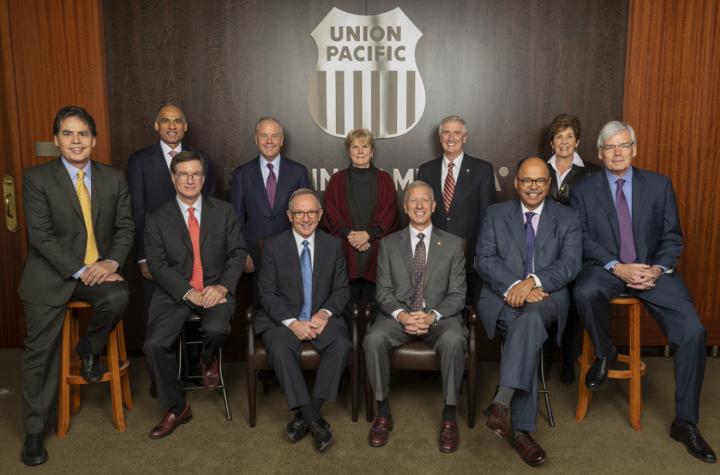
Union Pacific’s board of directors. Back row from left Bhavesh Patel, Thomas McLarty, Jane Lute, Andrew Card and Deborah Hopkins. Front row from left Jose Villarreal, David Dillon, Michael McCarthy, Lance Fritz, Erroll Davis and William DeLaney. Not pictured: Christopher Williams.
| 2019 Board of Directors Composition | |
|---|---|
| Number of Directors | 12 |
| Director Independence | 92% |
| Women | 17% |
| Minority | 25% |
| Average Age | 66 years |
| Average Tenure | 7 |
ESG Approach
Our business grows by understanding the needs of our communities and customers, and responding to those needs with dedication and commitment. Our environmental, social and governance (ESG) approach reflects this. We are committed to engaging employees in our mission, transporting products safely, providing family-supporting jobs, operating ethically, protecting and strengthening the environment, and investing in America’s communities.
Union Pacific’s chairman, president and CEO, and senior management oversee our corporate ESG strategy, and report progress to the board of directors. A cross-functional team is responsible for development and day-to-day sustainability management, while our approximately 37,500 full-time employees embrace and implement the strategy. We encourage employees to get involved and share their ideas on ways we can make a positive impact. Our stewardship is important – it’s a way to unify our diverse workforce around a single purpose.
Our ESG Goals
Union Pacific’s Building America Report details the company’s progress toward key pillars of our ESG strategy:
- Operating a safe, efficient, reliable and environmentally responsible rail network that delivers the best customer experience.
- Constantly improving employee and customer safety through training, education, innovation and investment.
- Developing programs and processes, making us an employer of choice.
- Growing our business profitably and responsibly so we can invest in the future and positively impact our stakeholders.
- Enabling a sustainable future by reducing our carbon footprint and helping our customers make meaningful change within their supply chains.
- Creating economic strength and improving quality of life in the communities where our employees live and work.
We track our performance toward these goals using the Key Performance Indicators (KPIs) shown in the table on page 13. Modeled after Global Reporting Initiative (GRI) standards, our KPIs align with our stakeholder groups’ priorities. Achieving success in each category directly impacts Union Pacific’s business. KPIs are updated annually in this report. Financial and safety performance results are presented during Union Pacific’s quarterly earnings calls.
Business and Industry Affiliations
Union Pacific is a member of many national industry and business organizations, including:
- Association of American Railroads
- Business Roundtable
- GoRail
- GreenBiz Executive Network
- Intermodal Association of North America
- Midwest Association of Rail Shippers
- National Association of Manufacturers
- National Association of Rail Shippers
- National Business Group on Health
- National Freight Transportation Association
- National Grain and Feed Association
- National Minority Supplier Development Council
- National Rail Labor Conference
- National Safety Council
- Operation Lifesaver
- Pacific Northwest Association of Rail Shippers
- Produce Marketing Association
- Southwest Association of Rail Shippers
- Transportation, Elevator and Grain Merchants Association
- United Fresh Produce Association
- U.S. Chamber of Commerce
- Women’s Business Development Center
- Women’s Business Enterprise National Council
Material Issues
Union Pacific completed a preliminary materiality assessment with input from internal and external stakeholders, including customers, shareholders and community leaders. We asked respondents to rate 19 key issues on a five-point scale based on the significance of Union Pacific’s ability to impact the issue and each issue’s level of importance. The results were used to determine our highest ranking material issues. Internal and external stakeholder groups were strongly aligned on most issues. Both ranked Customer Service and Satisfaction, and Rail Safety and Maintenance as high priorities. Not surprisingly, talent issues, such as Engagement and Employment Practices ranked higher among the internal group. We are proud of our Community Ties Giving Program, which provides support to more than 3,000 nonprofit organizations; however, we were surprised that Community Involvement and Corporate Philanthropy were ranked slightly lower in importance by the external group than the internal.
The materiality assessment results help us understand what’s important to each stakeholder and allow us to align business strategy to address the most material issues. It’s clear these issues also are important to investors who want to understand where we stand on material issues. In some cases, we’re already achieving great results; however, we need to do better at sharing them with our stakeholders. We anticipate completing a full materiality assessment in 2021.
Materiality Matrix
Governance & Risk Management
Talent
Business Operations
Safety & Security
Environment
Community
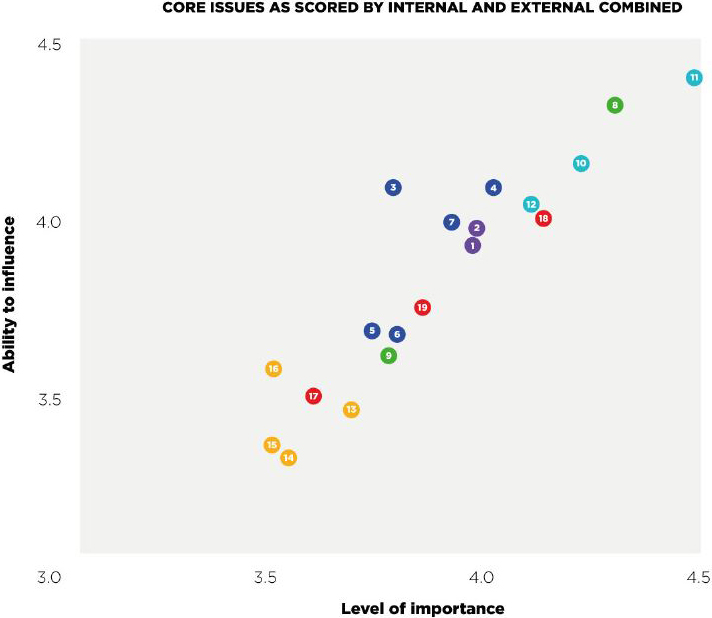
Highest-Ranked Material Issues
A complete list of the key issues and their definitions can be found in the Appendix.
Safety and Security
Material Issue
Rail Safety and Maintenance
Definition
Efforts to maintain quality rail infrastructure and prevent derailments, including track inspections and other measures.
Our Approach
- Our track inspection program customizes schedules and techniques to examine each rail line, mile by mile.
- State-of-the-art equipment is used to regularly inspect rail lines, locomotives and cars.
Material Issue
Emergency Preparedness
Definition
Measures taken to prepare for and reduce the impact of disasters, including but not limited to building relationships with emergency responders and preventing incidents involving hazardous materials.
Our Approach
- Union Pacific partners with customers, regulators and other stakeholders to conduct hazardous materials shipment inspections, sponsor training opportunities and actively participate in numerous industry initiatives focused on continuous improvement of hazardous materials shipments.
- We provide fire departments and other emergency responders along our routes with comprehensive training on minimizing derailment-related impacts, including classroom and hands-on training.
- We conduct drills and exercises with local, state and federal stakeholders.
- The Union Pacific Railroad Police Department is a team of highly trained special agents dedicated to maintaining the railroad’s security and integrity.
Material Issue
Digital and Physical Asset Security
Definition
Protecting the company’s critical physical infrastructure and data.
Our Approach
- Our Information Assurance team has robust processes and redundancies in place to prevent, detect and respond to potential threats.
- We perform regular vulnerability scanning and system penetration testing to validate our security controls and assess our infrastructure and software applications.
- Union Pacific uses Railway Alert Network materials for threat hunting and in our security awareness communications.
- Employees receive annual training to identify phishing attacks and how to avoid being victimized.
Business Operations
Material Issue
Customer Service and Satisfaction
Definition
Efforts to meet or exceed customer expectations and build productive customer relationships.
Our Approach
- Our Customer Experience team uses regular surveys to track trends and analyze data.
- A Customer Advisory Board is comprised of customers providing guidance on best practices.
Talent
Material Issue
Employment Practices
Definition
Employee compensation and benefits, and the efficacy of policies and practices that maintain a healthy and safe work environment, and promote employee well-being.
Our Approach
- Comprehensive benefits program, including medical insurance, educational assistance and a 401(k). Benefits vary based on the applicable collective bargaining agreement or an employee’s non-union status.
- Personalized health coaching, helping employees and their spouses manage stress, depression, smoking, diabetes, nutrition education and weight management.
- Employee Assistance Program, offering all employees and their families counseling and referral services for personal or work-related problems.
- System health facility program, giving employees access to gyms located near Union Pacific work sites.
- A diverse mix of training to aid in retaining employees and helping them progress their career.
Community
Material Issue
Infrastructure Investment and Protection
Definition
Investing in and protecting our network infrastructure, and working with regulatory officials to align our business with the country’s infrastructure requirements and needs.
Our Approach
- Union Pacific’s 2019 capital program totaled $3.2 billion, supporting infrastructure replacement, locomotives and equipment, commercial facilities and innovation.
Sustainable Development Goals
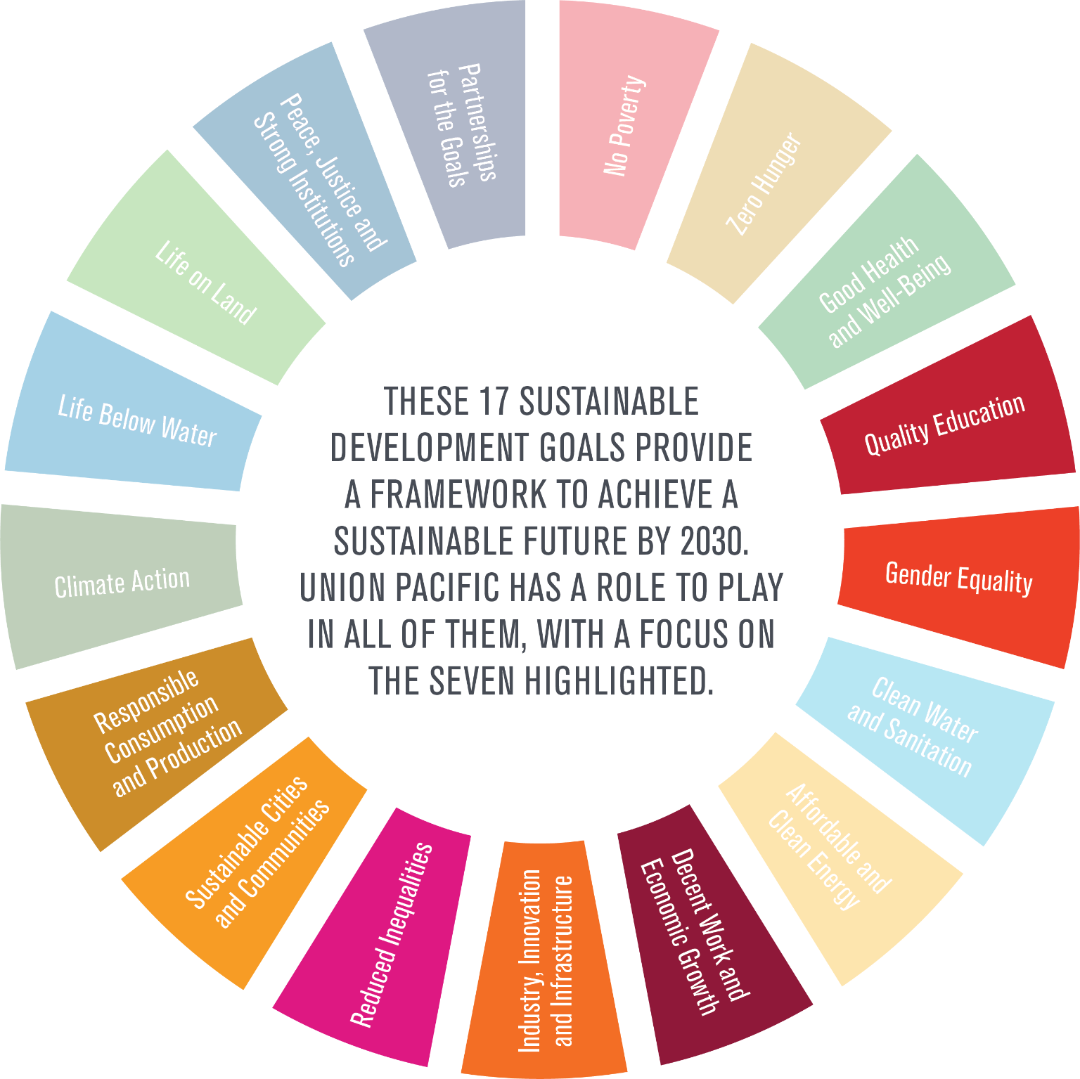
The Sustainable Development Goals (SDGs) were adopted by United Nations members with a target date for completion in 2030. They are aspirations aimed at all countries, governments and organizations, and with only 10 years to achieve these goals, world leaders are calling for action. Union Pacific recognizes that it’s our responsibility to act. Just as the railroad connects the nation, these goals connect the world, ensuring a better and more sustainable future for every person. We examined the SDG targets, identifying areas where we can align our business efforts to make the greatest impact.
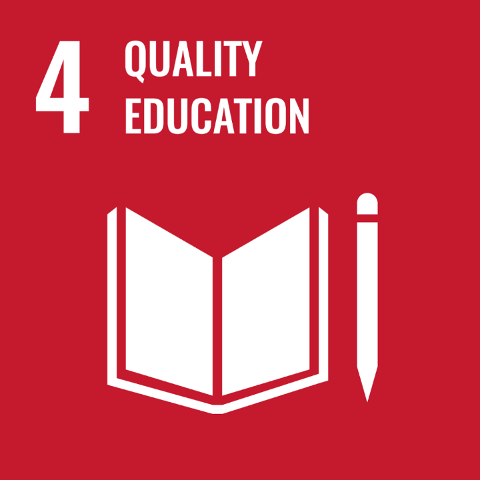
Quality Education
We believe education is the essential foundation for improving quality of life. The Community Ties Giving Program supports programs that put youth on the right track. We invest in programming that emphasizes Science, Technology, Engineering and Mathematics-related careers, like those offered at Union Pacific. It’s equally important students learn soft skills that are essential for thriving in a business environment. Our funding covers educational programs for youth, middle and high school, and adult learners.
Union Pacific is the largest private donor to the National Park Foundation’s Open OutDoors for Kids program, which provides transportation, programming and free entry for students to national parks. The majority of schools served are Title I, representing minority and underserved populations. We believe it’s important for students to explore the world around them while learning about science, history, conservation and their role protecting national and local treasures.

Gender Equality
The treatment of others is important to us. We are taking aggressive steps to remove barriers for women in a predominantly male-dominated rail industry. We work with trade schools that encourage women to see themselves in transportation, engineering and mechanical fields, and we offer the training needed to succeed. Once in the workforce, we’re making sure they have the tools to find fulfillment at work and home, balancing the needs of their family. For example, we now offer all lactating employees free overnight shipping of breast milk through Milk Stork when they are traveling for work. The program allows employees to continue providing for their children without the added stress of getting the milk home.
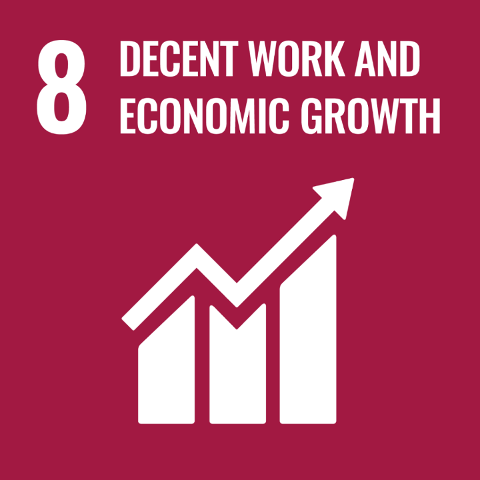
Decent Work and Economic Growth
Freight railroads are the backbone of the U.S. economy, supporting the livelihoods of employees in most sectors. One job in the rail sector supports eight others across the economy. We create economic opportunities for local communities through direct employment with Union Pacific, as well as prosperity created by local employee spending.
Union Pacific provides competitive compensation and benefits to approximately 37,500 employees across 23 states. We offer employment opportunities in many areas, from an office setting to working on or with trains. In some cases, a college degree or post-high school education is not required.
The rail infrastructure Union Pacific maintains and operates enables growth and innovation. By helping businesses form new partnerships, provide cost-competitive solutions and source new types of raw materials, our network supports the transition toward a more sustainable economy.
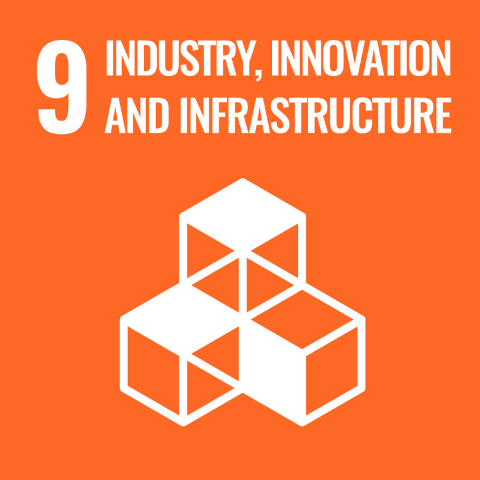
Industry, Innovation and Infrastructure
Union Pacific’s capital investments represent our commitment to building a sustainable rail network that can support economic growth for generations to come. We believe the more we invest in building a safe and efficient railroad today, the better our infrastructure can serve communities going forward. By 2045, U.S. freight shipments will increase by more than 40% and America’s population will grow by 70 million.2 Union Pacific has capacity to safely and reliably move additional goods, decreasing truck congestion on the nation’s already stressed highways and interstates.
From apps managing train systems to enhanced track inspection systems, we continually invest in new technologies that enhance safety, efficiency and service. We are also working to cut our carbon emissions, investing in locomotive upgrades that meet strict air quality standards and help us save fuel. Today, railroads are the most environmentally responsible way to move freight on land. On average, Union Pacific moves a ton of freight 444 miles on a gallon of diesel fuel, making us up to four times more fuel efficient than trucks.
2 Source: U.S. Federal Highway Administration
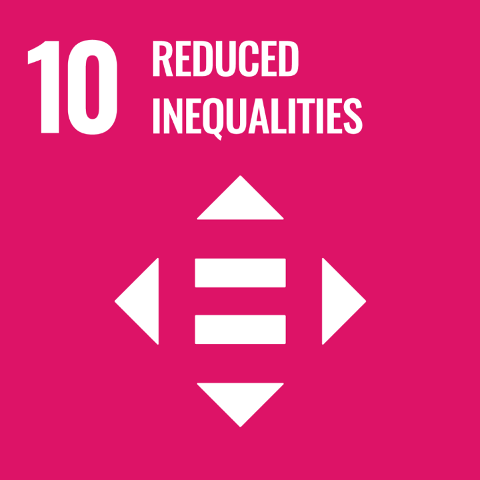
Reduced Inequalities
Union Pacific employees have the fundamental right to fair treatment within a discrimination-free workplace. We create a work environment that respects and values differences, which is essential for employees to reach their fullest potential. We are committed to a work environment free of offensive behavior regarding a person’s race, color, national origin, religion, gender, sexual orientation, age, gender identity, veteran status or disability. This includes offensive behavior directed at employees, customers, visitors to company facilities and others who employees may contact during the normal course of work, and we hold our partners in the supply chain, as well as nonprofit organizations that we support to these same high standards.
We believe diversity, equity and inclusion is the right approach and also our responsibility. These core values must extend outside the walls of our business and into the community. We want employees to live and work in places where they feel inspired, and that means interacting with people who have different opinions, backgrounds and experiences.
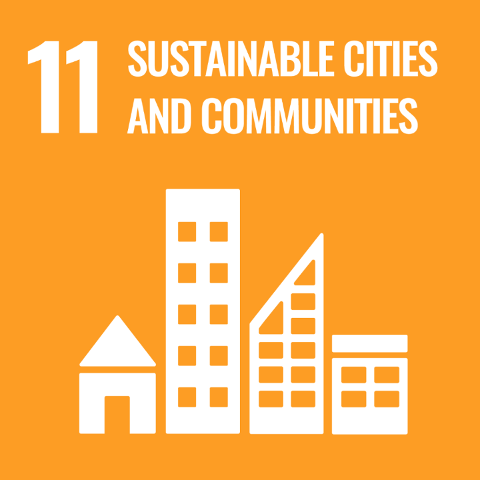
Sustainable Cities and Communities
Union Pacific moves the goods that families and businesses use every day, including the food we eat, the cars we drive, the chemicals to clean our water, and the steel and lumber to build our communities. We work with businesses to find solutions that decrease emissions and congestion on America’s already stressed highways and interstates.
Union Pacific generated an estimated 1.4 million tons of waste and diverted approximately 67% from landfills. We recycled about 485,000 tons of scrap metal in 2019, a higher volume than typical due to increased rail car scrapping. Metal is the second largest contributor – behind rail ties – to our success diverting recyclable materials from landfills. Steel, aluminum and copper are the most recycled materials on the planet and are found in a variety of unexpected products. From appliances to cell phones, buildings and highways, recycled materials are globally transforming construction and consumer products.
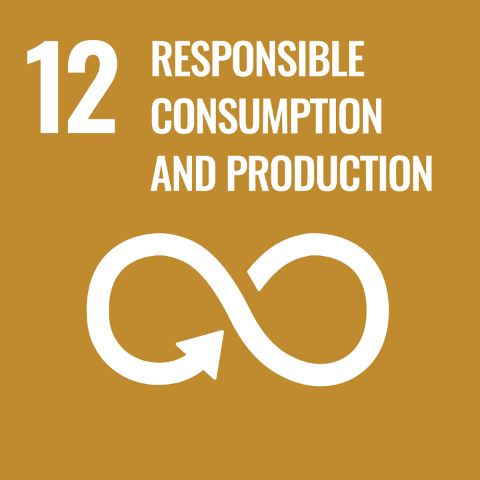
Responsible Consumption and Production
Our footprint touches many diverse ecosystems, and we are committed to being a responsible steward of the land we own. We work to preserve our ecosystems, improve our resiliency and reduce our impact. This is fundamental to ensuring a healthy environment and supporting vibrant local economies.
Fuel efficiency is a critical part of Union Pacific’s sustainability approach. We have employees dedicated to finding ways to reduce consumption as diesel fuel accounts for approximately 16% of our operating expenses. Fuel efficiency and carbon emission reductions fluctuate based on business volumes and commodity mix. Fuel efficiency improves as loaded cars add weight to the overall train.
Many parts of the country experience water stress in local and regional watersheds. The U.S. Global Change Research Program notes widespread stress in much of the Southwest, western Great Plains and parts of the Northwest. Union Pacific helps protect water resources from our operations in these areas with Stormwater Pollution Prevention Plans, as well as Spill Prevention Control and Countermeasures plans at our facilities. Wastewater treatment facilities capture and treat water from equipment washing and maintenance. We also treat captured wastewater to comply with government regulations and wastewater discharge permits.
Union Pacific used an estimated 905 million gallons of water, a decrease from 1.2 billion in 2018, and we continue exploring ways to conserve water by analyzing accounts, researching irregularities, and making changes and repairs to eliminate unnecessary use.
Union Pacific’s utility conservation projects reduced energy consumption by 2.7 million kWh, which is enough to annually power more than 247 U.S. homes. Many projects were employee-driven solutions, such as retrofitting lights with LED bulbs and upgrading air compressor systems. These solutions also provide guidance for future initiatives.
Key Performance Indicators
| FINANCIAL | 2017 | 2018 | 2019 |
|---|---|---|---|
| Reported Net income | $4.6 billion 3 | $6 billion | $5.9 billion |
| Operating revenue | $21.2 billion | $22.8 billion | $21.7 billion |
3 Non- adjusted to exclude the impact of Corporate Tax Reform. See Union Pacific’s website, under Investors, for a reconciliation to GAAP.
| OPERATING SAFELY | 2017 | 2018 | 2019 |
|---|---|---|---|
| Rail crossing accidents (per million train miles) | 2.55 | 2.69 | 2.72 |
| Reportable injury rate (per 200,000 employee-hours) | 0.79 | 0.82 | 0.90 |
| STRENGTHENING COMMUNITIES | 2017 | 2018 | 2019 |
|---|---|---|---|
| Capital program (private funds, no taxpayer dollars) | $3.1 billion | $3.2 billion | $3.2 billion |
| Spend with minority- and women-owned businesses | $406 million | $357 million | $328 million |
| ENGAGING EMPLOYEES | 2017 | 2018 | 2019 |
|---|---|---|---|
| Percent of unionized employees | 85% | 85% | 85% |
| Workforce diversity 4 | 6% Female 94% Male 2% Asian 12% Black 72% Caucasian 13% Hispanic 1% Native American | 5% Female 95% Male 2% Asian 12% Black 71% Caucasian 14% Hispanic 1% Native American | 5.5% Female, 94.5% Male 2% Asian 12% Black 71% Caucasian 14% Hispanic 1% Native American |
4 U.S. Population 2018 census estimates (permits reporting of more than one race): 6% Asian, 13% Black, 77% Caucasian, 18% Hispanic, 1% Native American.
| PROTECTING THE ENVIRONMENT | 2017 | 2018 | 2019 |
|---|---|---|---|
| Energy usage | 41.9 million megawatt hours | 44.5 million megawatt hours | 40.4 million megawatt hours |
| Water usage withdrawals | 1.14 billion gallons | 1.2 billion gallons | 905 million gallons |
| GHG emissions | |||
| Intensity per million gross ton miles | 12.37 metric tons | 12.80 metric tons | 12.45 metric tons |
| Locomotive fossil fuel emissions (Scope 1) | 10,216,978 metric tons | 10,874,731 metric tons | 9,688,964 metric tons |
| Fossil fuel emissions (Scope 1 and 2) | 10,989,985 metric tons | 11,760,366 metric tons | 10,415,469 metric tons |
| Employee travel (Scope 3) | 18,466 metric tons | 17,138 metric tons | 15,495 metric tons |
| Purchases from biomass sources | 125,359 metric tons | 122,692 metric tons | 127,645 metric tons |
| Waste | |||
| Total waste generated | 1.25 million tons | 2.09 million tons 5 | 1.43 million tons |
| Tonnage diverted from landfills | 70% | 71% | 68% |
5 2018 exceeded a typical year due to rail tie and petroleum-contaminated soil disposal. We also moved to a new waste tonnage calculation process.
Stakeholder Engagement
Union Pacific’s ESG approach requires engaging with our four key stakeholder groups to understand their evolving needs. Ultimately, we want to create competitive advantages for customers, job stability for employees, strong returns for shareholders and economic strength in communities.
Stakeholders
Employees
Union Pacific employees work 24/7 across our 23-state service area. We support and engage employees through the following channels:
- Communication from our CEO in many forms, such as online and in-person town halls with question-and-answer sessions; CEO videos covering key issues, including safety, Unified Plan 2020 and employee engagement; and a CEO blog highlighting observations from field visits and topics impacting the company.
- Information Television network.
- Senior management town halls with question-and-answer sessions.
- Employee clubs and resource groups.
- Focus groups and engagement surveys to gather direct employee feedback.
- Annual ethics training and regular ethics bulletins.
- A values line allowing employees to anonymously report concerns 24/7.
Customers
Union Pacific has strong relationships with its customers. At the heart of those relationships are multi-faceted communication efforts, enabling us to develop solutions that meet their changing needs and support growth. We engage customers through the following channels:
- Face-to-face, teleconference and virtual meetings.
- Our customer website and secure customer portal.
- Smartphone apps and mobile-friendly services.
- API integration.
- Track Record, our online magazine designed to help transportation and logistics professionals secure accessible, cost-effective and reliable solutions.
- Social media.
- Shipment notifications.
- Rail operation announcements and commercial updates from the executive vice president – Marketing and Sales.
- Customer surveys and forums for evaluations and suggestions.
- Our 24/7 Customer Care and Support team..
Communities
Union Pacific’s business positively impacts communities by creating economic growth and development for local businesses, providing career opportunities and reducing road congestion. We seek to support communities and manage potential negative impacts through the following channels:
- Local public affairs representatives who regularly work with elected officials, economic development alliances, civic groups and other community organizations.
- Our national 24/7 emergency hotline.
- Event sponsorships and employee volunteerism.
- The Community Ties Giving Program.
- UP CARES program.
- Free safety training for emergency responders.
- Inside Track, our website dedicated to sharing news, photos and video about Union Pacific, our employees and the communities where we live and work.
- Social media platforms, including Facebook, LinkedIn, Twitter, Instagram and YouTube.
Shareholders
Clear communication with shareholders is important to Union Pacific. We engage them through the following channels:
- Annual reports, proxy statements and SEC filings.
- Our Investor Relations site, featuring upcoming events, public filings, industry reports, shareholder resources and answers to frequently asked questions.
- Annual Building America Report.
- Shareholder meetings with management and investor conferences.
- Quarterly earnings reports and conference calls.
Other Key Audiences
Regulatory Officials
Union Pacific works closely with federal and state regulatory officials to align our business with the country’s infrastructure requirements, shaping a responsible and sustainable operating environment through the following channels:
- Transparent compliance reports, voluntary agreements and in-person meetings.
- Ongoing dialogue via staff in Washington, D.C., and across our network.
- Participation in the Association of American Railroads (AAR) and U.S. Environmental Protection Agency’s (EPA’s) SmartWay Transport Partnership.
- Employee and corporate regulatory and legislative advocacy.
- The Union Pacific Environmental Management Program.
- Collaboration with U.S. Customs and Border Protection (CBP) and other government agencies.
Suppliers
Suppliers are an important part of Union Pacific’s business, helping us serve our customers and provide quality materials. We manage suppliers through our Supplier Code of Conduct and Quality program, engaging them through the following channels:
- Electronic commerce capabilities.
- Supplier performance tracking system.
- Supplier diversity program.
- Face-to-face supplier meetings.
Key Awards and Recognition
Union Pacific is proud of the work we do delivering the goods Americans use every day, building a diverse and inclusive workforce, and strengthening communities. Our efforts were recognized with the following awards:
- Fortune’s most admired company among trucking, transportation and logistics.
- Ranked among the world’s largest transportation companies on the Forbes Global 2000.
- Included on the inaugural list of Forbes’ Best-in-State Employers 2019 for Nebraska.
- Executive Vice President and Chief Human Resource Officer Beth Whited listed on Fairygodboss’ 19 Gender Equality Superheroes in 2019.
- Named a Top Veteran-Friendly Company by U.S. Veteran’s Magazine.
- Recognized as a Military Friendly Employer by GI Jobs Magazine.
- 2019 HIRE Vets Gold Medallion Award winner, honoring investments in recruiting and employing American military veterans.
- Selected by Texas Monthly as an inaugural “Texan by Nature 20,” recognizing 20 top Texas companies dedicated to conserving natural resources.
- Named one of Inbound Logistics’ Green Supply Chain Partners.
- Loup Logistics, a Union Pacific subsidiary, recognized with Fiat Chrysler Automobiles’ Outstanding Performance – Intermodal Carrier award.
- TRANSCAER® National Achievement Award recipient.
The Great Race: 150th Anniversary Celebration
At noon on May 10, 1869, the “Golden Spike” ceremony began with approximately 600 people in attendance. Positioned nose-to-nose at the end of the last rail were Central Pacific’s Jupiter locomotive and Union Pacific’s No. 119. A bottle of champagne was broken over the ceremonial laurel tie while a telegraph went out across the nation with the simple message: “Done.” The transcontinental railroad was complete.
Union Pacific marked the 150th anniversary with a celebration that paid homage to our past and the remarkable achievements that connected the nation, while reminding us of the enormous responsibility we have for the country’s future. The May 9, 2019, ceremony was held at Ogden Union Station a day ahead of Utah’s celebration at Promontory Summit where the Golden Spike was originally tapped into place. Union Pacific no longer has tracks near Promontory Summit. They were removed to support the scrap metal projects during World War II.
The ceremony featured Union Pacific's iconic steam locomotives, Living Legend No. 844 and Big Boy No. 4014. The two met, recreating the historic image taken at Promontory Summit on May 10, 1869. The Big Boy is the world’s largest steam locomotive and one of eight still in existence. It's newly refurbished and the only one in operation, restored to celebrate this anniversary. Following the steam meet, Union Pacific Chairman, President and CEO Lance Fritz, Utah Gov. Gary Herbert and Rep. Rob Bishop were joined by Margaret Yee and Sandy Dodge to tap a ceremonial spike. Yee's ancestors were among thousands of Chinese immigrants who forged the transcontinental railroad for Central Pacific. Dodge is a descendant of Gen. Grenville Dodge, Civil War veteran and Union Pacific's chief engineer during construction.
Following the May festivities, the Big Boy and its Steam team spent three months touring Union Pacific’s system. Crowds gathered along the tracks, climbed trees and camped out for hours to see No. 4014. We estimate more than 1.1 million people experienced this piece of history. While some in the crowd relived memories of days gone by, a new generation fell in love with steam locomotives. It was remarkable to meet rail enthusiasts from all over the world who planned vacations just to see a Big Boy in action.
Thousands of videos and photographs captured the Big Boy on its cross-country journey. We created the Union Pacific Steam Club, which climbed to more than 44,000 members, giving enthusiasts a place to interact with the Steam team and share memories and experiences.
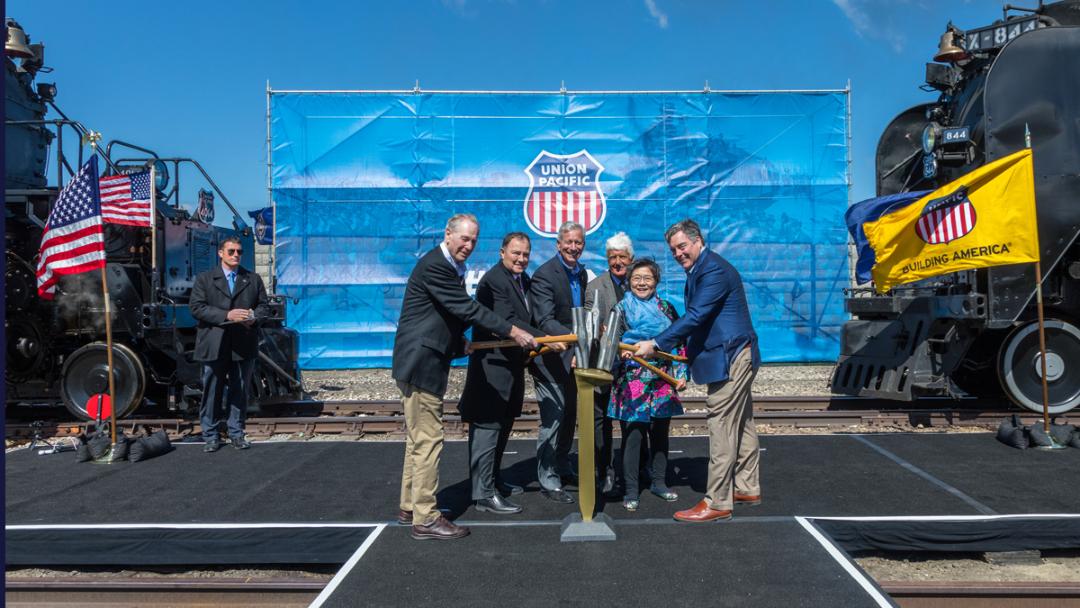
Recreating the tapping of the golden spike from left are Sandy Dodge, Utah Gov. Gary Herbert, Union Pacific Chairman Lance Fritz, Rep. Rob Bishop, Margaret Yee and Union Pacific Chief Administrative Officer Scott Moore.
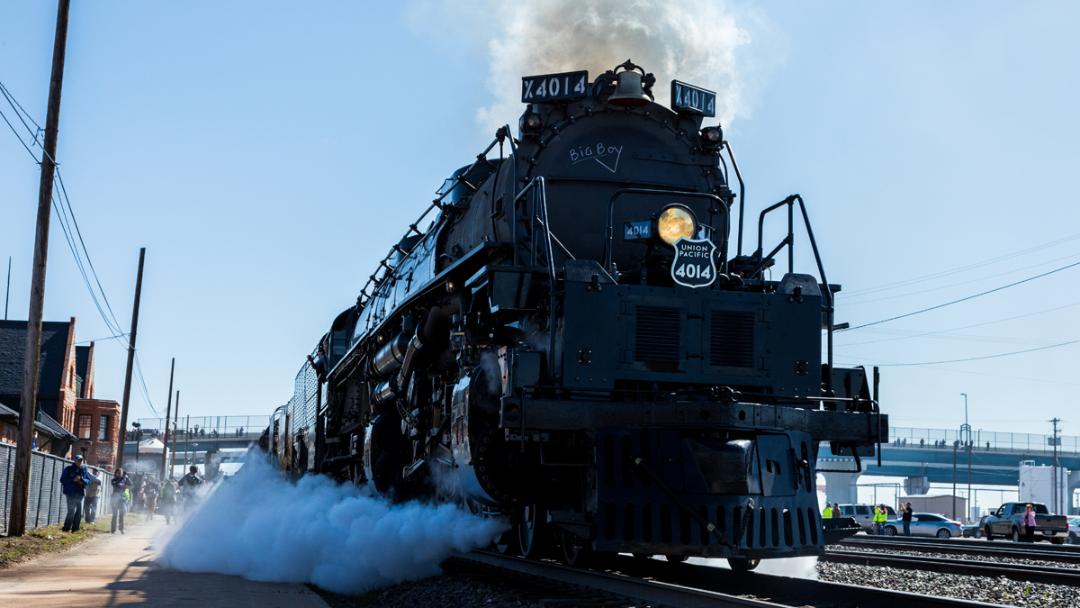
The Big Boy No. 4014 arrives for its christening celebration in Cheyenne, Wyoming.
What's Ahead
Union Pacific is a stronger, more agile railroad following 2019 and the work we did to change how we operate. 2020 is all about building on that strength for each of our stakeholders: employees, customers, shareholders and communities. We will continue to work toward being the safest, most reliable and consistent railroad by leveraging technology and the strengths of our employees.
We connect American businesses and communities to each other and the world, putting us in a unique position to help support the UN’s Sustainable Development Goals. Union Pacific plans to further refine our alignment, setting goals and tracking our progress to help provide a more sustainable future for every person on the planet.
